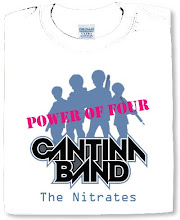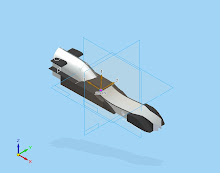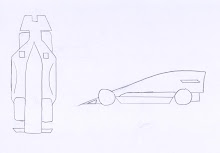
Sunday, August 17, 2008
Thursday, August 7, 2008
BERNOULLI'S PRINCIPLE
Bernoulli's Equation:  The Bernoulli's principle apapplies to any fluid, and since air around the car is a fluid, it applies to air.
The Bernoulli's principle apapplies to any fluid, and since air around the car is a fluid, it applies to air.
GUYS, HOPE THIS PHYSICS LESSON DIDN'T BORE YOU . =)
Prototype 1
Saturday, July 19, 2008
Brainstorming Session
- We draw out our list of targeted sponsors to fulfill our budget.
- Came to mutual agreement on how our final design will be like.
- Have a time table on what to do everyday.
- Divided our tasks accordingly.
- Pn Siti ( our teacher advisor) still drives really fast.
Manufacturing
Day : Thursday
Weather: Clear & Sunny
Conclusion: Good day for manufacturing!
We started our journey first thing after school. Only took 10mins to the manufacturing centre thanks to our teacher cum F1 driver. Dang, she was goin fast, real fast. Imagine 100km/hr across the city. We were lucky to arrive in one piece.
We started by picking the wood. Fyi, the car is made up of balsa wood ( some very light wood weighing at approx 100g ).

Our day than ends by a cup of coffee and a little chit chat or smiles.
Sponsor Meeting

Went to Cubic for sponsor...Huge factory
Had a meeting with University Technology Malaysia Melaka(UTEM). Beautiful place, nice building, talented professors.

- Entrance to the engineering department
We had a meeting with the board of professors in the engineering faculty. Don't ask, it was scary. Jim literally froze and didn't know what to say. We didn't know what to do at first without the great speaker, Joel. Finally, Jim gave a marvellous presentation in the helpless situation. He can't do anything but speak. "What is F1 In schools? What we need? What is the drag of the car? ......." Kudos to Kell Jim! Picture this: We went there unprepared without any presentation whatsoever and they ( the professors), were all set ready to fire tons of firepower worth of questions. So dead were we. Obviously.

The end results were promising though. The guys back there were so impressed with Jim's presentation, they agreed to sponsor us and even lend us a big helping hand by contributing ideas to our car design. They even allow us to have full access to their machines for our manufacturing purposes.
Job well done to the nitrates it is, life is a speedway!
Tuesday, July 8, 2008
The Test..
Joel Yip- Design Engineer
After producing few designs of the car, its time to test their drag.But how?
Simple. By using a virtual wind tunnel.
What is a virtual wind tunnel?
Simulating Race Car Design with Computational Fluid Dynamics
CFD is a computer-based technology that studies the dynamics of all things that flow.In Formula 1 racing, CFD involves building a computer-simulated model of a race carand then applying the laws of physics to the virtual prototype to predict what the downforce or drag may be on various components of the car or how the car willrespond in various wind conditions, changing environmental conditions or on differentroad surfaces.
Aerodynamicists can use CFD to better visualize and enhance their understanding ofhow various designs will perform. It also allows them to experiment with more designvariables in a shorter amount of time until they arrive at optimal results.
CFD allows engineers to use computer software to divide components of a race carinto specific cells or grids. For each of those cells, supercomputers are then used tocalculate mathematical equations that compute the velocity and air pressure of thewind as it rushes over, under and around the specified components of the race car.Aerodynamicists can use the resulting data to compute the downforce, drag andbalance the race car will experience, depending on different environmental and roadconditions and different design variables. When the calculations are finished, theaerodynamicists can analyze the results either numerically or graphically.
The Nitrates us CFD as the first step in their design and testing process,since it allows us to experiment with more design variables more quickly thanbuilding a physical model.
What Comes After the Virtual Wind Tunnel?
Our second step is to build a physical scale model of thecar and place it in a wind tunnel, where we can conduct further research andcontinue to assess the car's aerodynamic efficiency. After these two steps are completed, our final step is to test and assess the car on the track itself.
In the ongoing race to shave hundredths and thousandths of seconds off a race car'stime, Formula 1 teams seem set to continue their focus on advanced technology toaccelerate their design efforts.
Saturday, July 5, 2008
Job Division
Joel yip- Design Engineer
I'm sure you guys out there are wondering how the team works.
So, i'm goin to explain on what role each of us play in the team.
Team leader
- Guides the team and makes sure everyone is doing their part
- Takes the lead when any problems arise
- Encourages team members to strive and do their best
- Makes sure the assignments of team is handed in by the deadline
Design Engineer
- Understand the laws of physics and motion
- Create designs of cars through CAD
- Test the effectiveness of the car(speed)through the virtual wind tunnel
- Think of creative ways to increase the speed or reduce the drag of the car
Manufacturing Engineer
- Make the design engineer's vision become a reality
- Produce the winning machine based on the design engineer's concept and design
- Research on raw materials and their effectiveness
- Assemble the car and ensure that it is destined for greatness
- Paint the car based on the design engineer's concept
Resource Manager
- Handle the logistics of the team
- Ensure that there is enough resources to run the team
- Responsible for the budget and income(sponsers)
- Collaborate with the graphic designer to produce advertisements
- Produce uniforms for the team
Graphic Designer
- Design the Brochures
- Design the Portfolios
- Produce posters
- Produce an image for the team
The Budget
JOEL YIP- DESIGN ENGINEER
As we all know before producing something,the cash needed will always be an issue. Yes, its always about the money for the nitrates.
Here is our estimated budget needed to ace this competition:
- Manufacturing Of car- RM6000
- Printing - RM1000
- Pit Stop - RM2000
- Adertising - RM1000
- Michellaneous - RM1000
TOTAL - RM11000
So we as usual require the aid of our thrustworthy sponsers to contribute. In exchange, we will try our best to publicise/ advertise their company throught this competition. Those who are willing to sponser us pls contact:
- Teh Kell Jim (team leader/ resource manager) - k.jim_92@hotmail.com / 0166091111
- Joel Yip (Design Engineer) - 0173097415
- Or simply by just contacting the team through the team email- gonitrates@live.com
Your help is greatly appriciated. We will do our part and try our best to succeed with your aid.
the regionals
Joel Yip- Design Engineer.
As you guys have been informed, The Nitrates have overcome every barrier and have reached the southern region finals. Here are some useful information about this leg of the championship.
Competing Teams/ Opponents:-
- Swift Impulse - our homeground rival
- V-Thrust - another homeground rival
- Faster 1
- Speed Auto
- F40 Team
- F1 Girls
- MOZAC
- D'Putra
- Meltec F1
- Indigo Swift
- Silver Arrow
- Light Speed
- Porcupine
- Terminal Velocity
- Synergy Teens
- Lightspeed Breaker
- N.O.S.
- Phoenix Drage
- Aero Lightning
- The Provident
- Air GEar
- Time
- Flash
- Phoenic
- Sonic Tuner
- Percesion V
- Aero Force
Presentation: 31 July 2008 nationals
Race: 1 - 2 Aug 2008
Venue: Air Keroh D'Village Resort, Melaka
Team Hopes/ Goals:
- Able to represent the southern region to the
- Emerge as Overall Champions
- Fastest Car Award
- Best Engineered car Award
Life is a Speedway
Monday, June 30, 2008
Reasons for participation...
Objectives:
-To design, construct, manufacture and race the fastest Formula One Car of the future, driven by compact compressed reclaimed CO2 (carbon dioxide gas) power plants.
-To emerge as a champion regionally and represent southern region to the national level!
- To obtain knowledge in the fields of Science and Technology and gain experience.

World Championship 2008
 F1 For Schools World Championship 2008
F1 For Schools World Championship 2008Venue: Sunway Resort

The track - 20 metres from start to finish.
 And the cars...
And the cars...




What is F1 for schools - The Competition
It's a competition for teams of three to six school children to design and manufacture miniature CO2-powered racing cars and then race them at regional, national, and international levels. Organized by The Formula One In School Incorporated and supported by Ministry of Education, it’s open to all Form 4 secondary school students within the season. Participating students use state-of-the-art software programs that enable them to play around with CAD (Computer Aided Design) and CFD (Computational Fluid Dynamics), just like real F1 designers.
They have to manage the whole project from scratch, from drawing up a business plan and raising the sponsorship, to financing it through the design and manufacturing stages, to a presentation in front of a panel of preeminent judges.
Student teams will compete against each other at the next national finals to determine who will represent Malaysia to the 2009 World Championships!
Why F1 Schools Technology Challenge Introduced ?
The F1 in Schools Technology Challenge exists to raise the profile of engineering across schools and colleges around the world. CAD / CAM, CNC and VR system are now common place in the manufacturing industry, which is why it is so important for the engineers and designers of the future to get to grips with it earlier on.
The F1 in Schools initiative creates a fun and motivating environment for students to experience the engineering process. The worldwide popularity of F1 racing lends excitement while providing a relevant background for simulating critical elements of engineering in the real world.
Primarily, F1 in Schools provides students with an ideal opportunity to experience the very latest developments in manufacturing technology
Experiencing Engineering
Students form their own F1 teams to research, design, manufacture, and ultimately race their own scale model F1 cars. The process simulates many facets of real F1 racing.
From a design and manufacturing perspective, students use CAD (computer-aided design) software to create virtual 3-D models of their cars and translate their designs into reality by means of CNC milling machines.
Team organization is critical to the project. Teams must have a minimum of three to a maximum of six members who fill the following roles: team manager, resources manager, manufacturing engineer, design engineer, and graphic designer.
Teams must also promote their cars through a variety of marketing efforts, such as procuring sponsors (if possible); developing sponsorship decals and a consistent color scheme; and producing a design folder with initial design ideas, design development information, testing evidence, and graphical renderings
Lastly, the object of the exercise is to make these miniature projectiles travel a 20-meter distance in the shortest time possible.
The current record is 1.02 seconds, an average speed of 19.6 m/s. To put that in perspective, that’s faster than Fernando Alonso’s Renault could manage over the same distance, not withstanding its 900bhp cargo in the back!
Mission
The F1 in Schools initiative was set up in 2000 as a way of raising the profile of engineering as a career option and assisting the teaching of the subject in schools and colleges.
Since that time, some two million children have taken part, and it has expanded into an international competition. Twenty-two countries have signed up to this year’s contest, and the winners of each national competition will face each other in the world final.
It is hope that through direct experience of the technology and processes required to complete this project, students will be encouraged to explore and/or pursue a career in the car design, engineering and manufacturing industries.
The design and rules present a different engineering and design challenge to test and develop engineering skills even further, besides cultivating interpersonal skills as team work is an important element of the Challenge.
About us...
They are four different students with different backgrounds and personalities and have completely nothing in common but their passion for speed meet up. Thus, the ‘Nitrates’ was formed. The team has gone through thick and thin, many problems arise during the process of victory but they managed to pull through together and stand strong till the end. Now, after qualifying for the southern region championship, the road to the nationals, the team once again are working day and night in order to produce the ‘the winning formula one car’- our pride and joy, “Godspeed”. However there still lies an obstacle for them to overcome. The process of manufacturing the car and turning their little pieces of inspirations and bright ideas into a reality, the recipe for success. And of course lacking of fund is the major problem for us to proceed smoothly.
>Teh Kell Jim (Jim)- Team Leader / Resource Manager
>Joel Yip - Design Engineer
>Yeow Kin Yoong - Manufacturing Engineer
>Lee Kin Mun - Graphic Designer
One Team, One Family.
'From FRIENDSHIP... to PARTNERSHIP'
Life Truly is a Speedway.
































